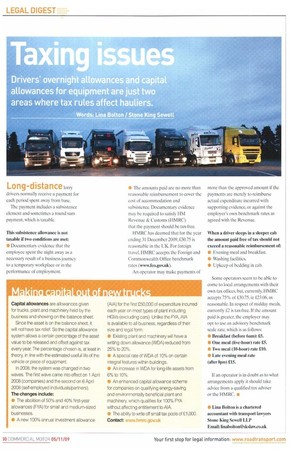Capital allowances are allowances given for trucks, plant and machinery held by the business and showing on the balance sheet
Page 30

If you've noticed an error in this article please click here to report it so we can fix it.
Since the asset is on the balance sheet, it will not have tax reltef, So the capital allowance system allows a certain percentage of the asset value to be released and offset against tax every year. The percentage chosen is, at least in theory, in line with the estimated useful life of the vehicle or piece of equipment.
In 2008, the system was changed in two waves. The first wave came into effect on 1 April 2008 (companies) and the second on 6 April 2008 (self-employed individuals/partners). The changes include: • The abolition of 50% and 40% first-year allowances (FYA) for small and medium-sized businesses.
• A new 100% annual investment allowance
(AlA) for the first 250,000 of expenditure incurred each year on most types of plant including HGVs (excluding cars). Unlike the FYA, AIA is available to all business, regardless of their size and legal form.
• Existing plant and machinery will have a writing down allowance (WDA) reduced from 25% to 20%.
• A special rate of WDA of 10% on certain integral features within buildings.
▪ An increase In WDA for long-life assets from 6% to 10%.
• An enhanced capital allowance scheme for companies on qualifying energy-saving and environmentally beneficial plant and machinery which qualifies for 100% FYA without affecting entitlement to AIA.
• The ability to write off small tax pools of £1,000. Contact: www.hmrc.gov.uk
















































































































































